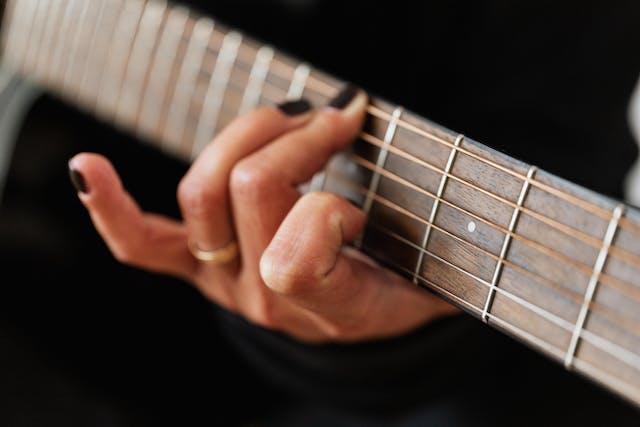Chord Inversions: From Simple Basics to Creative Musical Harmonies

Table of content
Chord Inversions: From Simple Basics to Creative Musical Harmonies - Introduction
Chord inversions, a fundamental concept in music theory, play a crucial role in enhancing harmonic richness and diversity in musical compositions.
At its core, a chord inversion occurs when the arrangement of notes within a chord deviates from its standard form, with a note other than the root placed at the base.

KEY TAKEAWAYS
Fundamental Concept of Chord Inversions: Chord inversions are a technique in music where the notes of a chord are rearranged so that a note other than the root is in the bass position. This rearrangement significantly alters the chord's tone and character, enhancing the harmonic richness of musical compositions.
Impact on Musical Harmony and Texture: By placing different notes in the bass position, inversions add depth and variety to music. They offer a fresh perspective on familiar chords, creating diverse soundscapes within a composition.
Benefits in Transitions and Voice Leading: Chord inversions facilitate smoother transitions between chords and improve voice leading in compositions. They allow for more cohesive and fluid movement in both solo and ensemble pieces.
Tool for Creative Expression and Improvisation: Musicians use inversions to inject personal style and creativity into their performances. They serve as a powerful tool for improvisation, enabling artists to explore new harmonic landscapes.
Practical Applications in Performance and Composition: Chord inversions make playing easier on instruments like the piano and guitar, offering a wider palette for accompaniment and songwriting. They are essential for a deeper understanding of musical structure and theory, aiding in more sophisticated musical endeavors.
Understanding Chord Inversions
Taking a standard C major chord as an example, it’s typically made up of the notes C, E, and G, with C being the root and positioned at the bottom.

However, in a chord inversion, either E or G would be placed at the lowest point of the chord, changing the root note's position.
Essentially, chord inversions offer a way to play the same chord differently, enriching musical harmony and adding depth to compositions.
Benefits and Applications of Chord Inversions
Chord inversions, a key element in music composition and arrangement, offer a range of benefits and applications that significantly enhance musical pieces.

Smoother Transitions: Chord inversions allow for smoother and more subtle transitions between piano chords. By using inversions, composers and musicians can move between chords with minimal changes in hand position or voice leading, creating a more fluid and cohesive sound.
Melodic Bass Lines: Inversions can be used to create more interesting and melodic bass lines. Instead of the bass simply following the root notes of chords, inversions enable the bass to move in a more melodic and engaging way.
Harmonic Variety: Utilizing chord inversions introduces a different harmonic flavor to music. Even when the same chords are used, inversions can make a progression sound entirely new, providing variety without changing the overall harmonic structure.

Enhanced Musical Texture: Inversions add complexity and richness to the texture of music. They allow for a broader range of harmonic possibilities and can be used to emphasize certain notes within the chord.
Improved Voice Leading: In choral or polyphonic arrangements, chord inversions help in achieving smoother voice leading. They facilitate the natural movement of individual musical lines, enhancing the overall flow and cohesion of the piece.
Creative Expression: Musicians often use inversions to put their own stamp on a piece of music, offering a unique interpretation and creative expression. It allows for personalization in performance and composition.

In conclusion, chord inversions are more than just a musical technique; they are a powerful tool for composers and performers, offering creative flexibility, enhancing musicality, and providing a means to explore new dimensions in harmonic progression and arrangement.
Chord Inversions in Practical Playing
In practical application, these inversions allow for various improvements and enhancements in performance, whether one is a beginner or an advanced player.
Ease of Playing: Inversions can make playing chords easier, especially on instruments like the piano or guitar. By using inversions, players can transition between chords more smoothly, reducing the need for large hand movements and making it easier to maintain a consistent rhythm.
Variation in Sound: Utilizing chord inversions changes the sonority of the chords, giving musicians the ability to alter the mood and tone of a piece subtly. This variation can be particularly useful in genres like jazz or classical, where color and texture are pivotal.

Enhanced Accompaniment: For accompanists, chord inversions provide a way to support the melody more effectively. By choosing different inversions, an accompanist can either blend in with the melody or provide a contrasting harmony, thereby enriching the overall sound.
Improvisation and Creativity: Inversions are a great tool for improvisation. They offer a wider palette of sounds and possibilities, encouraging musicians to explore new harmonic landscapes and express their creativity.
Understanding of Musical Structure: Learning and using chord inversions deepen a musician's understanding of music theory and chord structures. This knowledge is essential for more advanced musical studies and compositions.
Songwriting and Arrangement: For songwriters and arrangers, chord inversions provide a means to experiment with different harmonic progressions and find the most suitable arrangement for their piece, adding depth and originality to their compositions.
In practical playing, chord inversions are not just a technique to be mastered; they are a pathway to greater musical expression, offering a means to explore, innovate, and refine one's playing style.

Chord Inversions - Conclusion
Chord inversions extend far beyond the basic foundations of harmony, opening doors to a world of creative and expressive possibilities in music.
They are not merely a technical skill but a vital element in the language of musical expression, allowing musicians to explore nuanced soundscapes and rich harmonic textures.
By mastering chord inversions, players can achieve smoother transitions, more compelling arrangements, and a deeper emotional impact in their performances.
Whether in songwriting, composition, or improvisation, the use of inversions is a testament to the musician's commitment to artistic growth and exploration.
Ultimately, chord inversions represent a bridge between the technical mastery of music theory and the creative freedom of musical expression, enabling musicians to communicate more effectively and emotively through their art.
Thanks for reading,
The CalypsoRoom Team
Frequently Asked Questions (FAQs)
What is the definition of a chord inversion in music theory?
A chord inversion in music theory is when the notes of a chord are rearranged so that a note other than the root becomes the lowest note. This technique changes the chord's bass note but keeps its harmonic function intact.
How do first, second, and third chord inversions differ?
First, second, and third chord inversions are differentiated by which note is in the bass: the first inversion has the third, the second inversion has the fifth, and the third inversion (in seventh chords) has the seventh as the lowest note.
Can chord inversions be used in all music genres?
Chord inversions can be used in all music genres, offering versatility in harmonic progression and enhancing musical expression across diverse styles.
How do chord inversions impact the harmony of a song?
Chord inversions impact a song's harmony by changing the bass line and texture, leading to smoother transitions and a more nuanced emotional expression.
Are there specific techniques to learn chord inversions on the piano?
Specific techniques to learn chord inversions on the piano involve practicing the rearrangement of chord notes, enhancing fluidity and ease in transitions.
What role do chord inversions play in guitar playing?
In guitar playing, chord inversions are key for creating diverse voicings and richer harmonic textures, enhancing the instrument's accompaniment capabilities.
How can understanding chord inversions improve music composition?
Understanding chord inversions can improve music composition by providing more harmonic options, leading to richer and more complex musical arrangements.
back
Written by CalypsoRoom Editorial Team
The CalypsoRoom Editorial Team is a skilled and diverse group of writers, researchers, and industry specialists who have access to Calypso's data and information in order to give you broad knowledge about the music industry as well as helpful advice to help you manage your music and dancing career.
Updated January 2024
Company number: 681223
James's Walk 31, Dublin, Ireland
contact@calypsoroom.com
+353 (89) 435 8928



